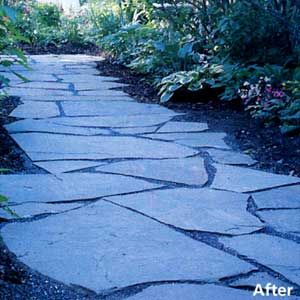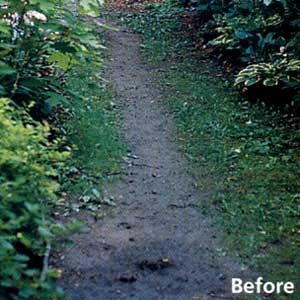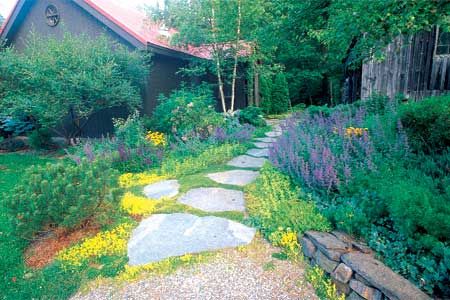A stone path can transform your muddy side yard into an inviting and functional passageway to your outdoor space. Whether you want to enhance your garden’s charm or simply create a usable walkway, our guide walks you through how to lay down a stone path. We’ll explain stone types, preparation, materials needed, and installation steps.
Types of Stones for Pathways
Each type of stone differs in appearance, durability, and installation method. These are the most common types of stones for creating pathways:
- Flagstone: Large, flat stones with irregular shapes
- Bluestone: A type of flagstone with a blue-gray color
- Cobblestone: Small, rounded stones
- Slate: Thin, layered stones with a smooth surface
- Granite: Rugged stones available in various colors and shapes
Choose a stone that fits your budget, home style, and maintenance preferences.

Planning Your Stone Path
Consider the path’s purpose, location, and overall design to make sure it meets your needs and complements your landscape.
Determining Width and Length
The width and length of your path depends on available space and how you plan to use it. Here are some guidelines:
- For single-person use: 30–36 inches wide
- For two people walking side by side: 48 inches wide
- For accommodating a riding mower: 50–60 inches wide
Measure the area where you plan to install the path. Think about any curves or turns you want to incorporate into the design.
Choosing the Right Stone Material
When picking a material that complements your home’s exterior and landscape, consider factors such as the following:
- Color and texture
- Durability and weather resistance
- Slip resistance and safety
- Cost and availability
- Ease of installation
For example, bluestone is popular for its strength and attractiveness. It’s available in various sizes and thicknesses, making it suitable for many types of path designs.

Materials Needed for Stone Path Installation
What your project requires depends on the type of path you’re laying, but you’ll generally need the following items.
Tools
- Shovel
- Rake
- Wheelbarrow
- Plate compactor or hand tamper
- Level
- String and stakes
- Rubber mallet
- Tape measure
- Safety gear (gloves, safety glasses, dust mask)
Materials
- Filler material for joints (sand or rock dust)
- Stone pavers or flagstones
- Gravel or crushed stone for the base
- Sand for the leveling course
- Landscape fabric (optional)
- Edging material (if needed)
Preparing the Ground for a Stone Pathway
Taking your time with preparation can save you effort and possibly money in the long run.
Marking the Path
- Place stakes at the beginning and end of the path.
- Tie a string between the stakes to create a straight line.
- Adjust the string to create curves if desired.
- Use spray paint or flour to mark the outline on the ground.
Excavating the Area
- Remove grass and topsoil within the marked area.
- Dig to a depth of 9–10 inches for a stable base.
- Level the bottom of the excavated area.
- Compact the soil using a plate compactor or hand tamper.
Creating a Solid Foundation
A solid foundation prevents your stone path from settling and shifting over time.
Adding and Compacting the Gravel Base
- Line the excavated area with landscape fabric if desired.
- Add a 4–6-inch layer of gravel or crushed stone.
- Rake the gravel to create an even surface.
- Compact the gravel using a plate compactor.
- Use a hand tamper for hard-to-reach areas.
Applying the Leveling Course
The leveling course provides a smooth surface for laying the stones.
- Spread one to two inches of fine builder’s sand over the compacted gravel.
- Use a rake to smooth the surface.
- Run a string between two stakes along the length of the path to show the finished surface is level.
- Check the sand level against the string and adjust as needed.
Laying the Stones
With the foundation prepped, it’s time to lay the stones and create your path.
Arranging the Stones
Start at one end of the path and work your way to the other. Place stones close together, fitting them like puzzle pieces. Aim for one-quarter-inch gaps between stones. For irregular stones, match convex edges with concave sections of adjacent stones.
Setting and Leveling Each Stone
Twist each stone into the sand to set it. Tap the stone with a rubber mallet to ensure it’s firmly in place. Check that each stone is level with adjacent stones and the string guide. Adjust the sand beneath stones as needed to level.
Filling the Gaps
Sweep sand or rock dust into the joints between stones. For bluestone paths, use damp bluestone rock dust to complement the pavers. Moisten the filler with a fine spray of water to help it settle. Add more filler and moisten again if necessary to build it up.
Adding Edging (If Necessary)
If using small pavers or bricks, consider adding permanent edging to help prevent the stones from spreading. You can install plastic, metal, or stone edging along the sides of the path, then secure the edging according to the manufacturer’s instructions.
Maintaining Your Stone Path
Proper maintenance will keep your stone path in good condition.
Regular Cleaning Tips
- Sweep the path regularly.
- Rinse with a garden hose to remove dirt and prevent staining.
- For tougher stains, use a mild detergent and soft brush.
- Avoid using harsh chemicals that may damage the stone or surrounding plants.
Addressing Common Issues
Even with a well-thought out plan, you may encounter some roadblocks during or after installation. Here are some common problems and how to solve them.
- Settling: Add sand or gravel under sunken stones to level them.
- Loose stones: Reset stones and add filler material as needed.
- Weed growth: Remove weeds promptly and consider using a weed barrier fabric during installation.
Sprucing Up Your Stone Path
Consider adding additional design elements to enhance your stone path. Here are some ideas.
Incorporating Plants and Greenery
Adding plants along the sides of your pathway can create a lush and inviting atmosphere. Consider low-growing ground covers such as thyme or creeping Jenny. Use taller plants such as hostas or ornamental grasses for borders. Be sure to select plants that thrive in your climate conditions.
Using Lighting for Ambience
Pathway lighting adds safety and beauty to your stone path at night. Install solar-powered path lights for an eco-friendly option. Use LED string lights for a whimsical touch, or place lights at intervals to highlight curves and steps.
Our Conclusion
Whether you choose a traditional flagstone walkway or a more casual stepping-stone design, proper planning is key to laying a beautiful stone path. Take your time choosing the best material, size, and shape. Once you’ve laid a foundation you like, enhance its appearance with greenery, lighting, or outdoor decor items.

